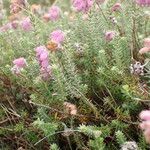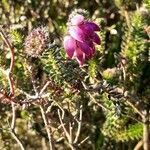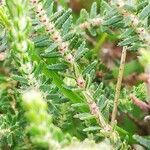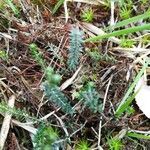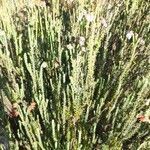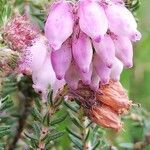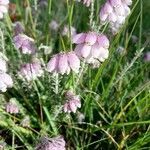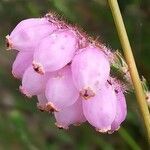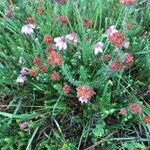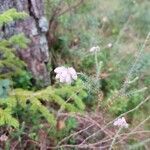Plants erect or ascending, 10-25 cm; twigs of current season green, with both appressed and spreading, stiff hairs, older twigs brown, glabrescent. Leaves in whorls of 4; petiole 0.1-0.3 mm; blade linear-lanceolate, flat, 3-5.5 × 0.5-0.7 mm, margins revolute, not prickled, abaxial surface stiffly short-hairy, adaxial sparsely, stiffly short-hairy (hairs ca. 0.1-0.2 mm), mixed with longer, glandular hairs (hairs 0.5-0.6 mm). Inflorescences terminal umbels, capitate, 0.8-1.6 cm. Pedicels 2-3 mm, glabrous. Flowers: calyx lobes narrowly deltate, 2.5 × 0.6-0.8 mm, margins entire, with short, stiff hairs, apex obtuse, with short, stiff hairs; corolla light pink, campanulate, 4-5 mm, lobes deltate, 0.5 mm, apex acute; stamens 10; filaments ca. 3 mm; anthers awned, ca. 0.7 mm, awns 2, basal, subulate, ca. 0.7 mm; ovary hairy; style 3-4 mm; stigma included, not slender, capitate. Capsules 1.5-2 mm. Seeds ellipsoid-ovoid, 0.3 × 0.3 mm, reticulate. 2n = 24.
More
A small spreading shrub. It grows 30 cm high and spreads 50 cm across. The leaves are grey-green and sword shaped. They are arranged in rings of 4. They are silver underneath. The flowers are pale pink. Some varieties have dark, rose-red flowers. They are urn shaped and in groups at the ends of branches.
Shrub to 4 dm; lvs narrowly oblong, at least the younger ones canescent, glandular-ciliate, as also the sep and bracts; cor ovoid, 7–8 mm; anthers with long basal appendages; 2n=24. Locally from Me. to N.J. and in W.Va. July–Sept.
Can be grown by cuttings or seedlings. Seeds needs stratification.

